Category Archives: Not a bird
Dinner? Red dragonfly looms over fly
“Come into my parlour,” said the dragonfly to the fly:
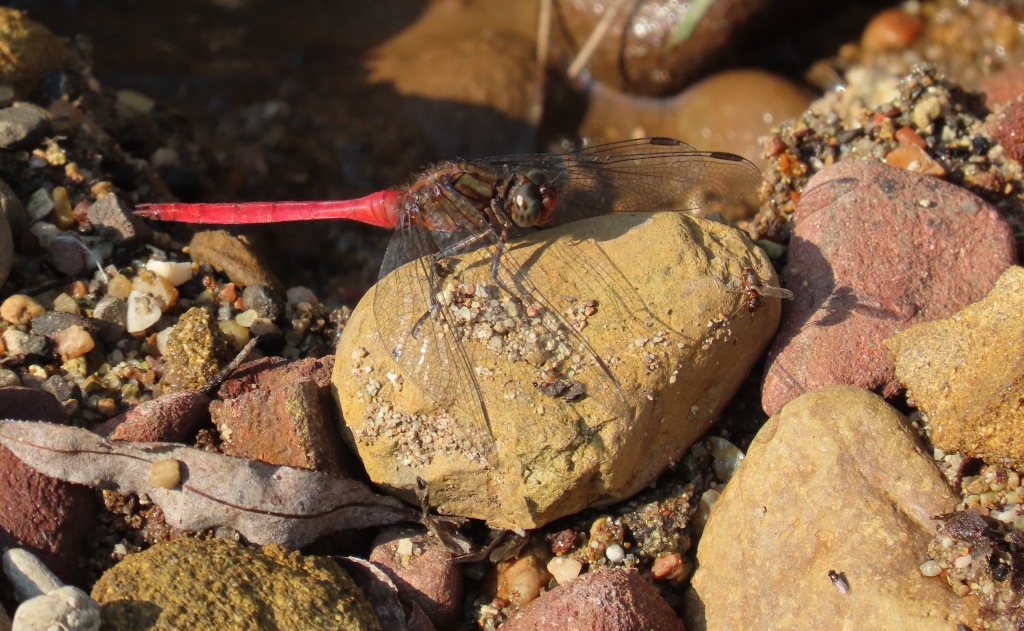
In the beautiful area of Cedar Creek yesterday, near Pokolbin State Forest, a red dragonfly sat on a rock. I took a couple of photos. When I zoomed in, I saw the fly almost under the dragonfly’s wings. The fly’s shadow gives it away. Another, smaller, fly, sits seemingly unaware on a nearby rock.
Here’s the dragonfly in a different pose:
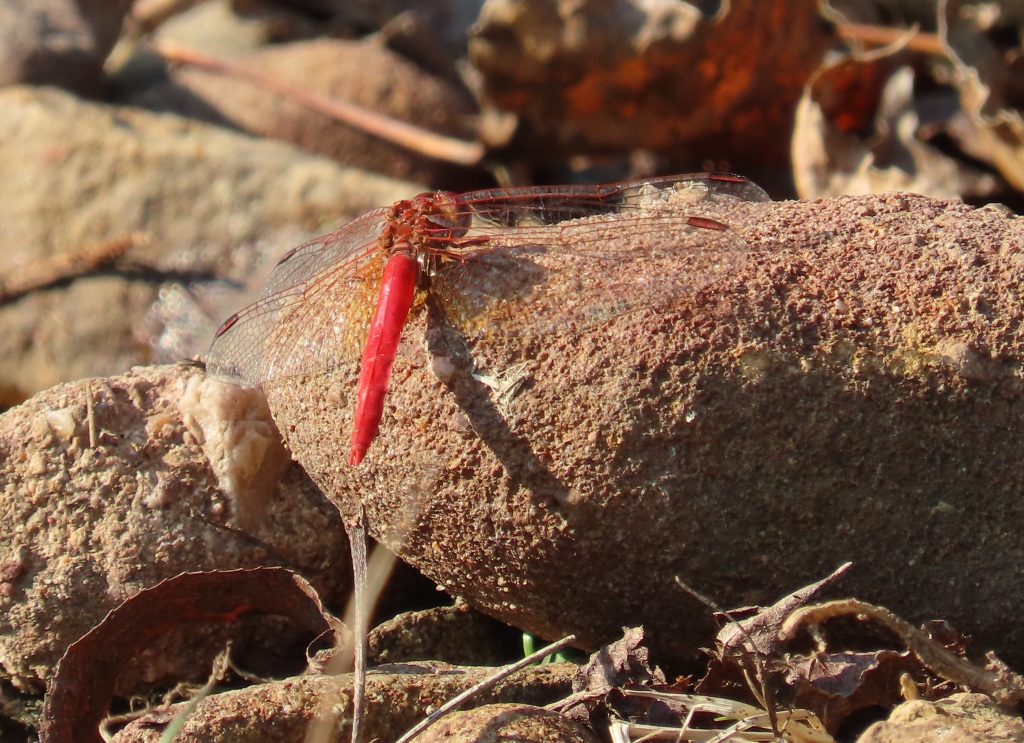
Wallabies and kangaroos near Capertee
Last week I was in a beautiful part of New South Wales, near a little town called Capertee to the west of the Blue Mountains. I’ve published a few blog posts about some birds in the area. Another group of creatures that caught my eye were the wallabies and kangaroos.
The wallabies in Capertee look quite different from those in my area near Sydney. I’m used to seeing Swamp Wallabies, also called Black Wallabies (here’s a recent post about them). They’re quite dark in colour, whereas the wallabies that I saw further west are a lighter grey-brown overall, with pretty black markings on their faces. They’re called Black-Striped Wallabies:
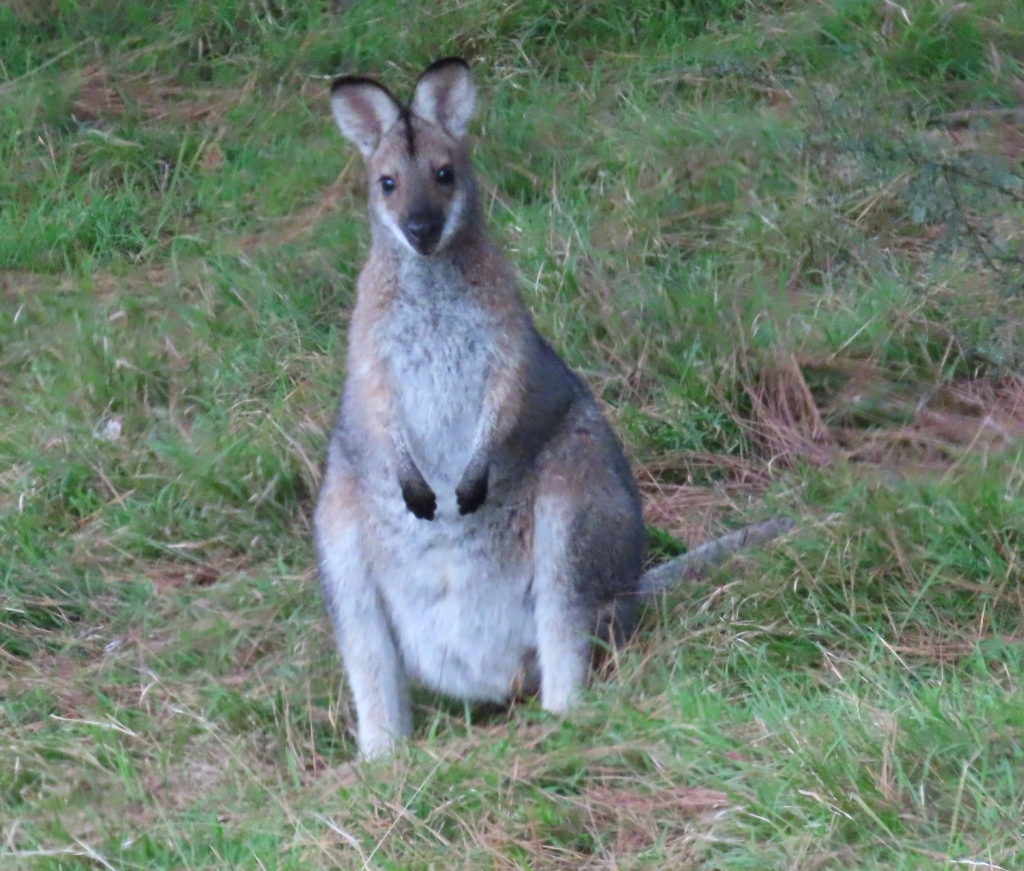
The Black-striped Wallabies are listed as endangered in New South Wales. Here’s another one:
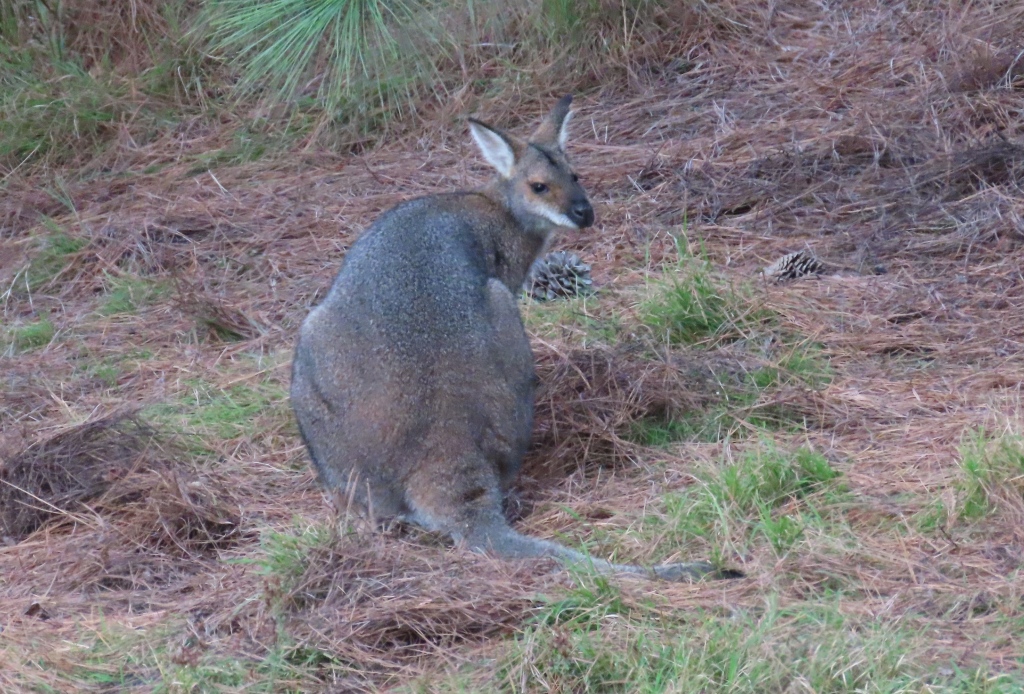
These wallabies are about 80 centimetres tall (31 inches), whereas Eastern Grey Kangaroos are much larger — up to two metres in height. Here’s one of the kangaroos that I saw on an early morning walk near Capertee:
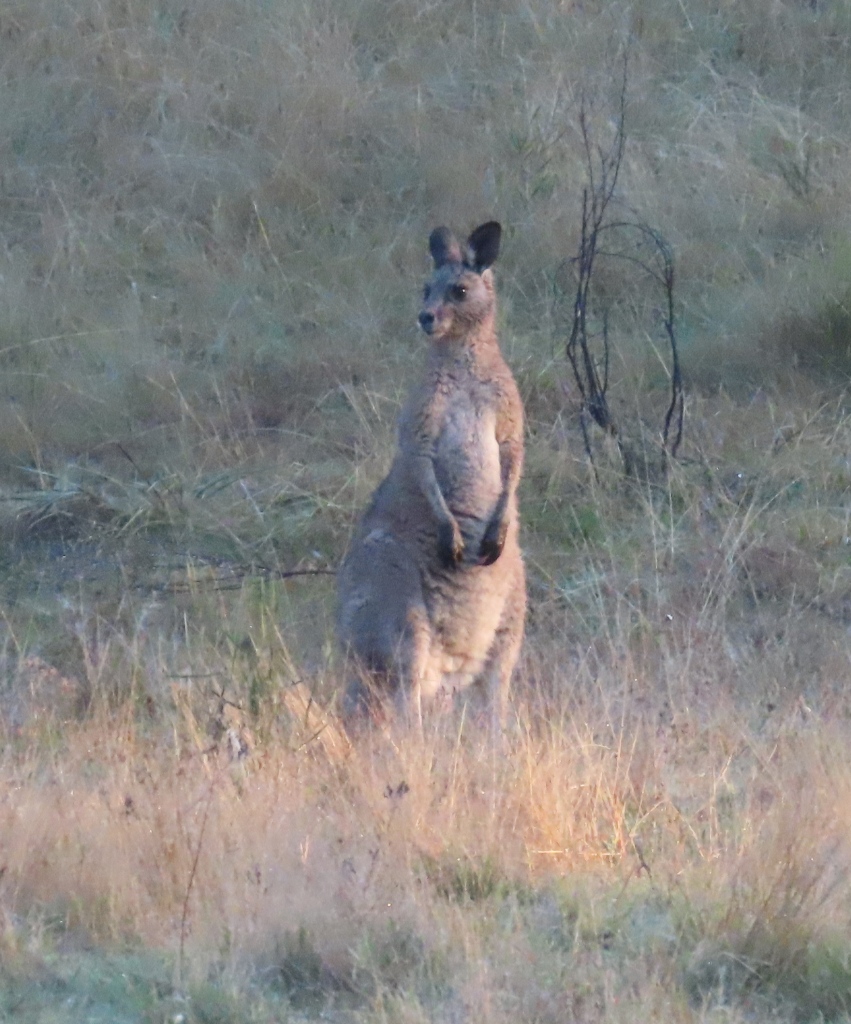
Capertee and surrounds are absolutely gorgeous. I’d highly recommend a visit!
Water dragon chillin’ in a tree
This Australian Water Dragon has draped itself over a tree branch, catching some sun on a cool wintry morning:
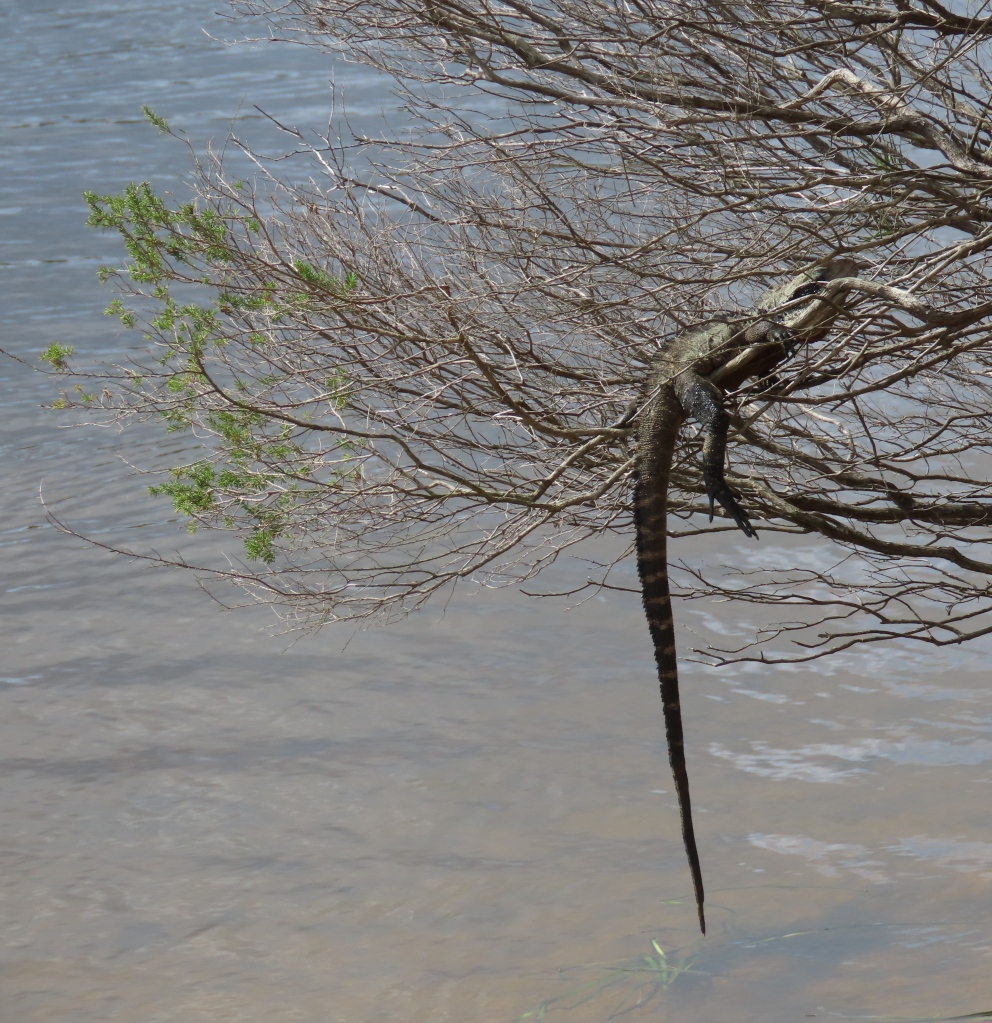
Here’s a close-up of that lovely head, eye closed in a lazy doze:
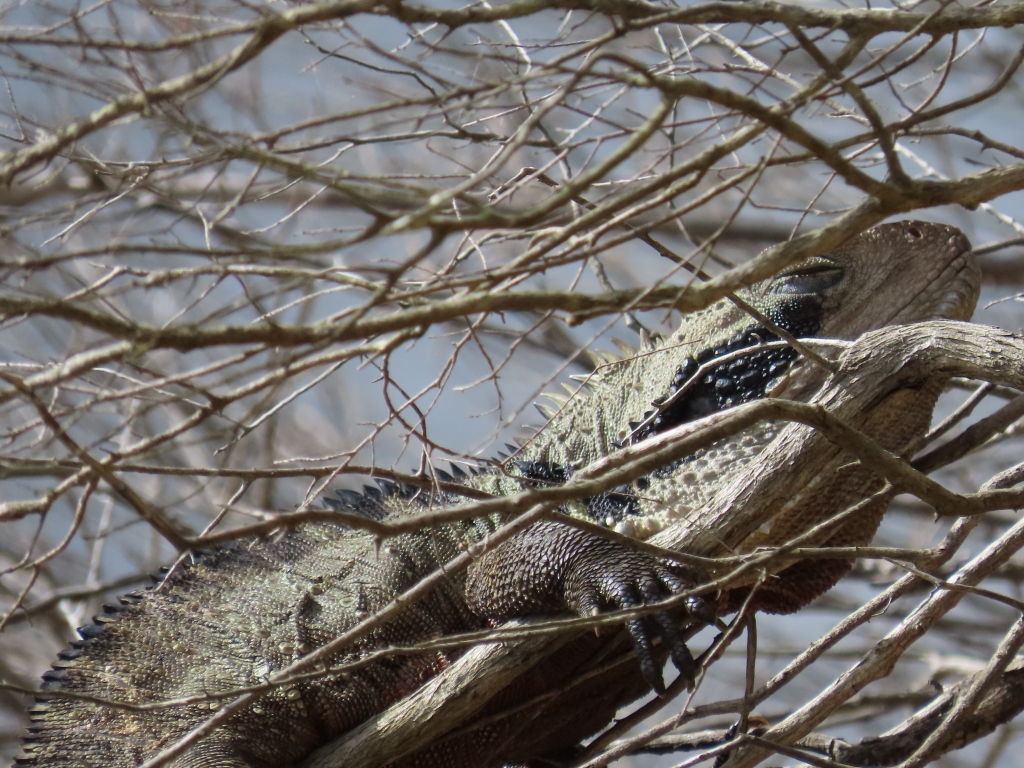
Australian Water Dragons (Intellagama lesueurii) are large dragon lizards, reaching a length of more than two metres. During the cold winter months, they burrow a hole for themselves, then slow down their metabolism and go into a state of brumation. We’re in the middle of autumn now — it must be about time for this one to head underground! They eat insects, flowers, and fruits such as figs and Lilly Pilly berries.
I spotted the Water Dragon at Manly Dam, north of Sydney, Australia. Here’s a zoomed-out view of the scene. You can see the lizard’s tail hanging down from the bush on the right-hand side of the dam:
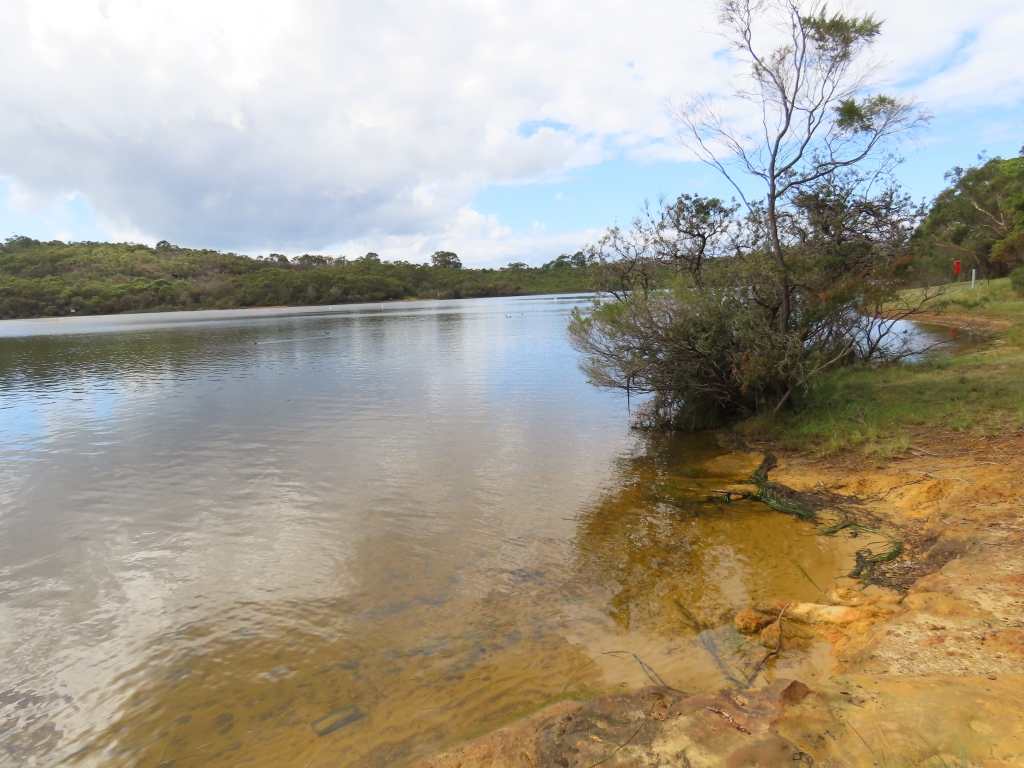
Red-bellied Black Snake at Turon River
This post is not about a bird. Instead, it’s about a large and beautiful snake that I encountered near the banks of the Turon River in New South Wales. We were travelling along Upper Turon Road, on the way from Capertee to Sofala. I brought the car to a quick halt when I noticed the snake in the middle of the road:
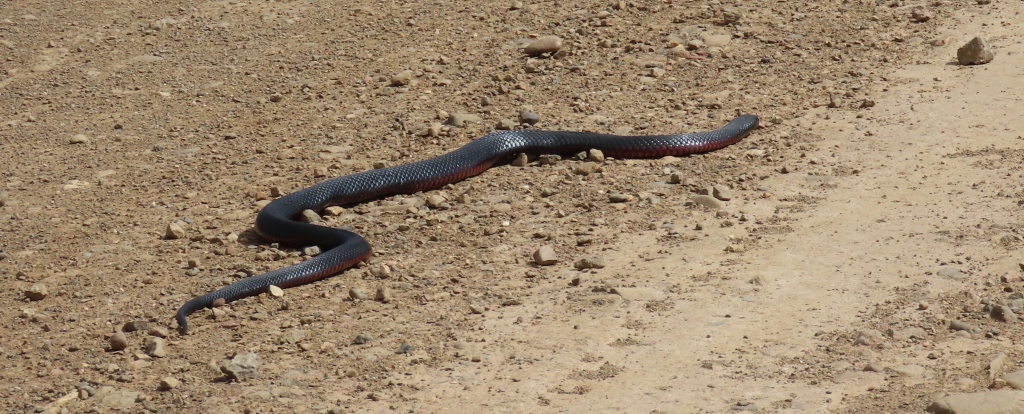
It was close on two metres long, and very lively indeed. We jumped out to take some pictures. The snake moved off the road onto the grass and came over to have a look at us:
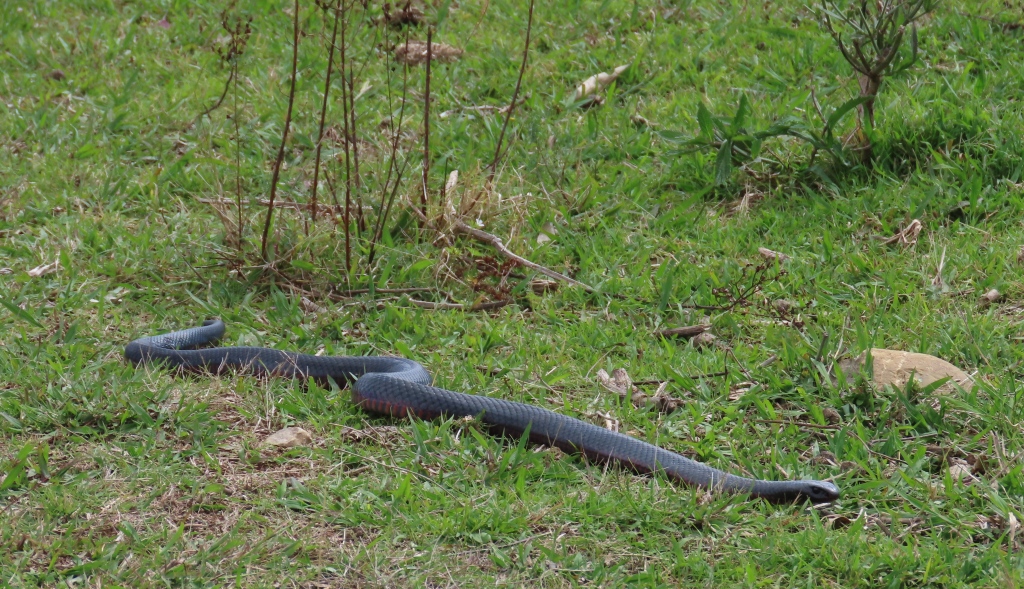
It’s a Red-bellied Black Snake (Pseudechis porphyriacus). Evidently their bites are rarely fatal, although the venom can cause quite severe illness. Usually, these snakes move away from humans. This one was an exception. It appeared to be very interested in us, and we kept well clear of it while admiring its beauty.
This video shows the snake making its way off the road onto the grass:
It felt like a great privilege to encounter this creature as it went about its daily life.
Mother wallaby with baby in pouch
Swamp Wallabies are a type of small kangaroo (macropod) found in eastern Australia. I see them relatively often when I’m out walking through the bushland areas in the early morning. Recently, the number of wallabies in my area of Sydney seems to have grown: at any rate, I see them more often I did than a few years ago.
This morning, I saw this mother at Manly Dam park, with a little one in her pouch:
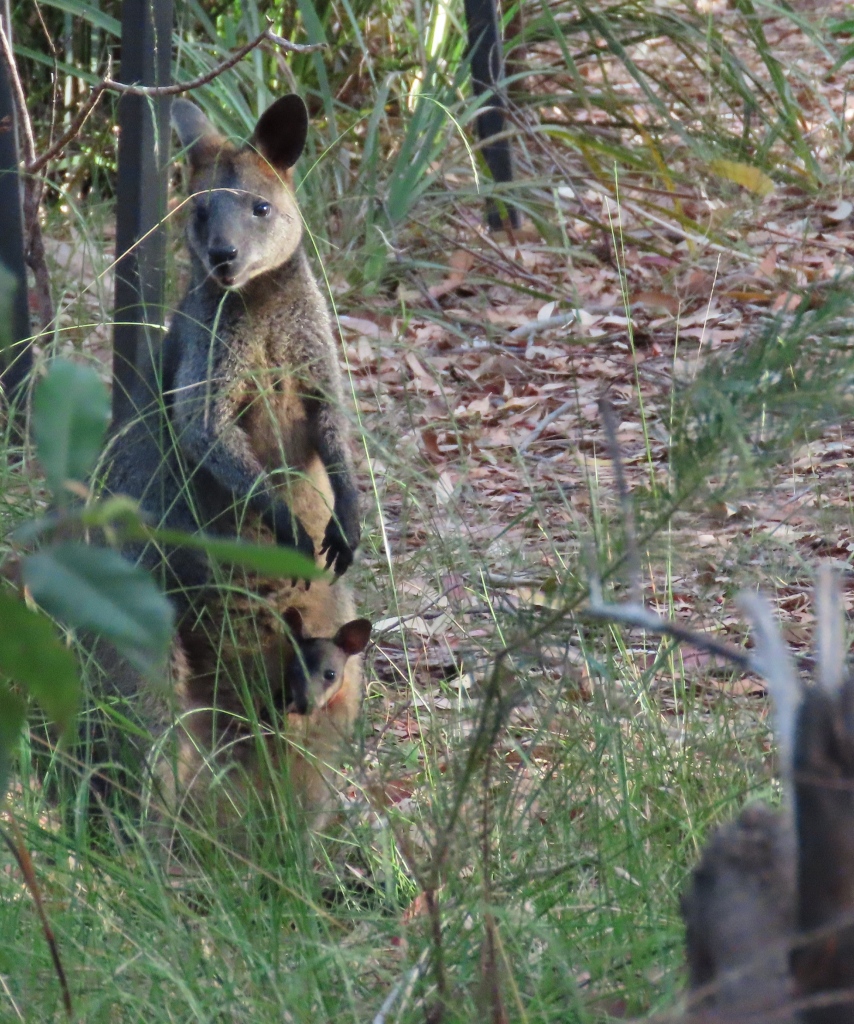
Swamp Wallabies are also called Black Wallabies. They’re relatively small, reaching up to my chest when they stand on their haunches. Their colour ranges from very dark grey to a lighter grey, with reddish patches around the ears and on the underbelly.
They’re marsupials. The little one, called a joey, stays in the pouch for around eight months, until it can live independently. In the picture above, you can see its head peeking out of the pouch.
In the next picture, the joey was withdrawing into the pouch. Only one ear and part of its face are visible:
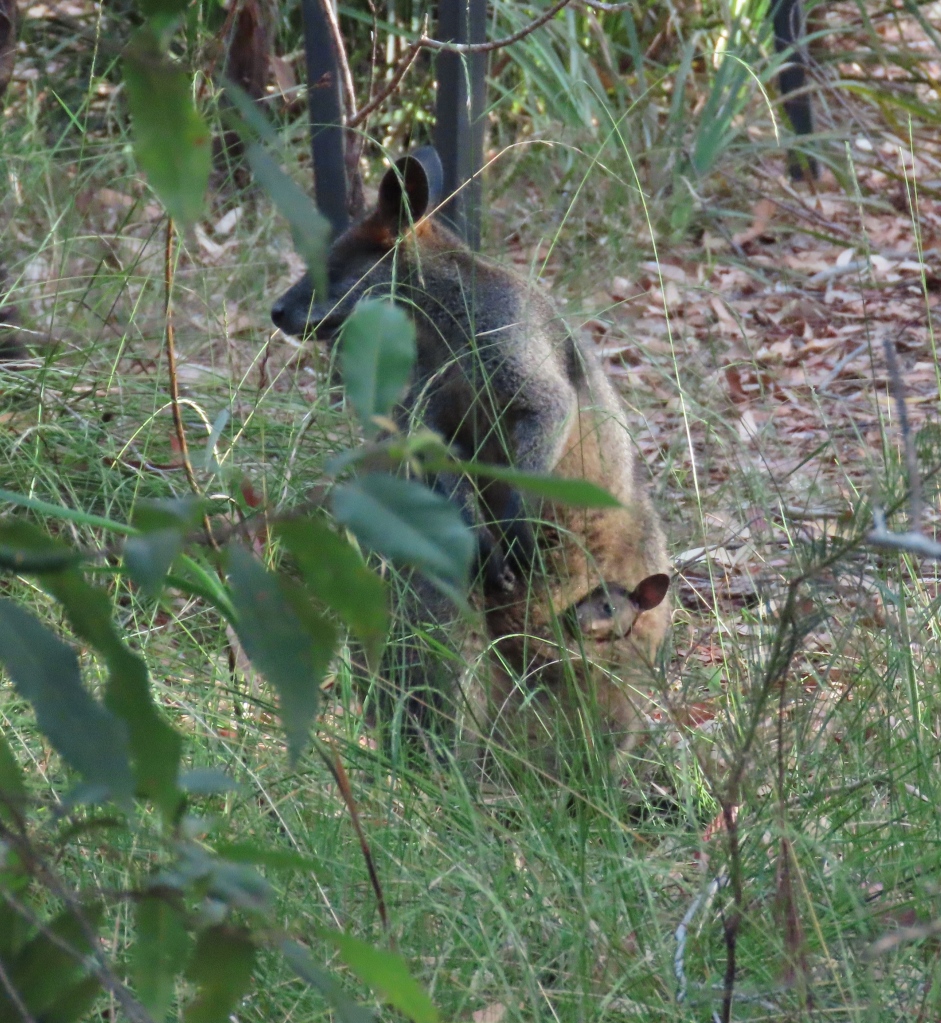
Here’s a short video showing the mother moving around and eating leaves while the youngster looks out at the world:
Generally, wallabies are quite timid and will move away when you approach them along a path. A few days ago, though, I came across one individual who squared up to me and held his ground. This was in a different area of Sydney, on a harbour walk near Balgowlah. The path passed within four metres of the wallaby. It’s breeding season at the moment, and I was probably getting a little close for comfort. I certainly felt a little uncomfortable too, as the animal rose up, turned to face me, and swished its strong tail through the undergrowth to get purchase for a potential fight:
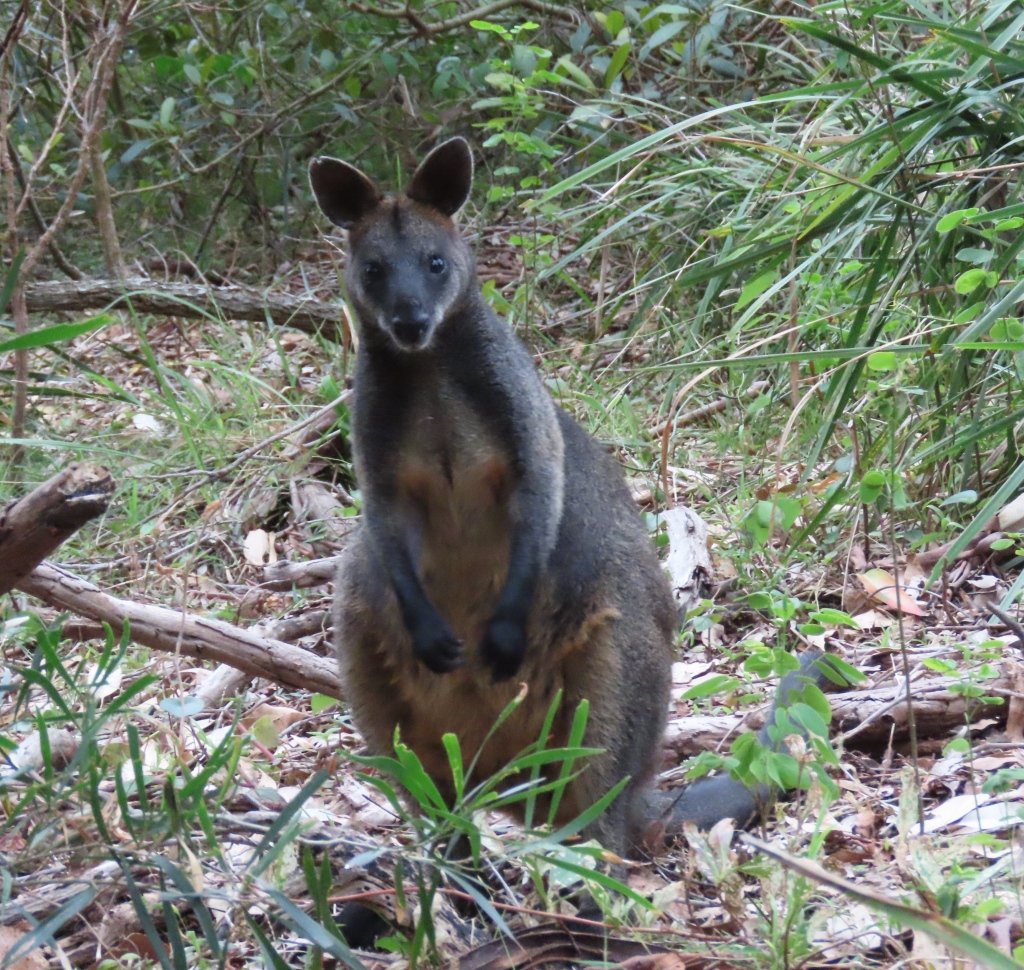
Possums in the day time
A couple of days ago, when walking along a coastal path near Sydney, I saw a dark shape at the top of a bare tree:
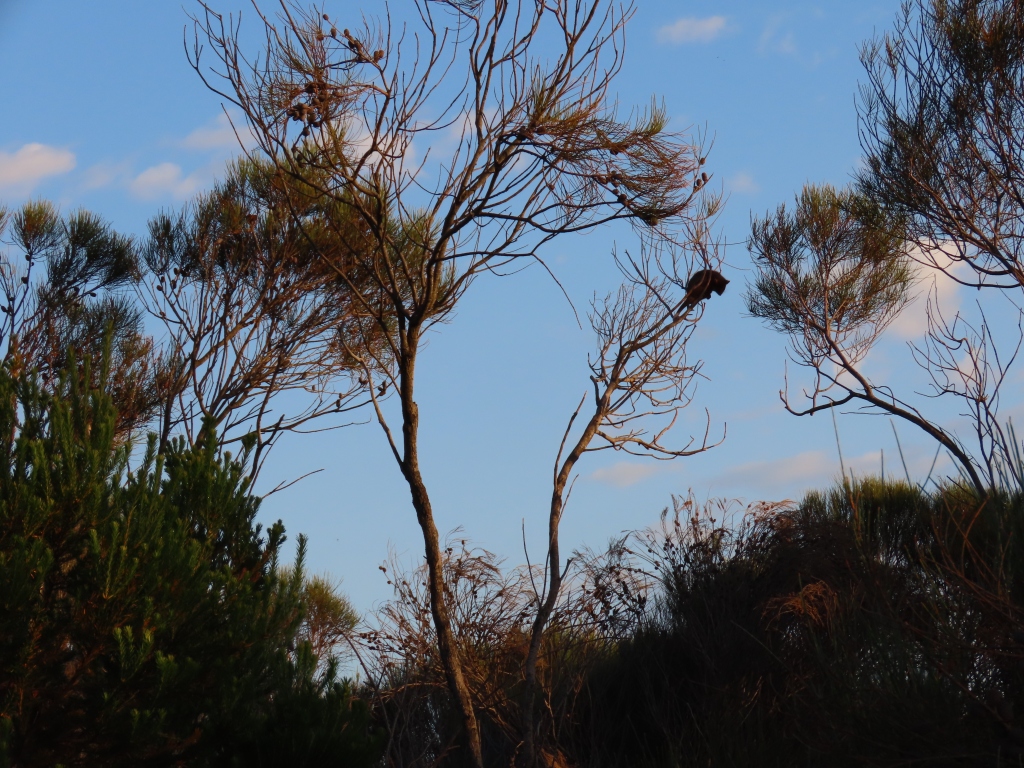
It’s very unusual to see possums out in the daylight. They’re usually active in the dusk and twilight hours. When the sun comes out, they’re tucked into their nests asleep.
This possum was very still. I watched it for about 10 minutes and it didn’t move an inch. I wondered whether it was dead. Perhaps it had been killed by an owl and left there while the bird went on an errand? Then, in a tree close by, I saw two more possums:
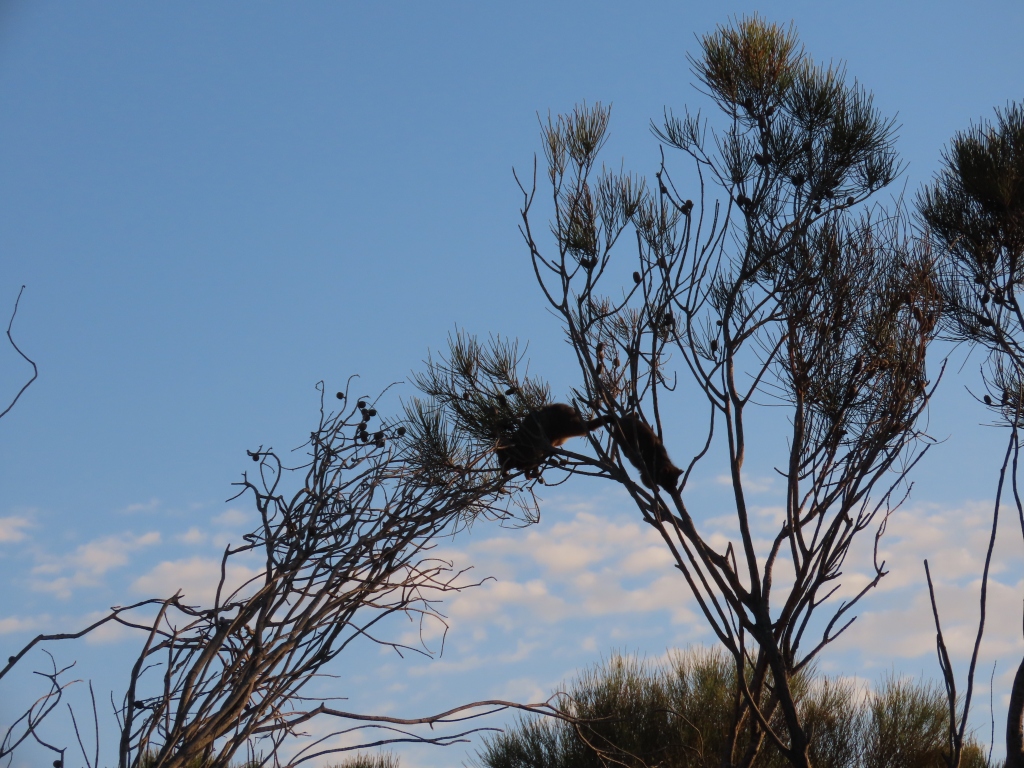
These two were similarly unmoving. No owl would kill three possums, so I felt a stirring of hope. Perhaps the animals were living up to their name and playing possum?
At last, one of the possums came to life:
These are Eastern Ringtail Possums. They’re about the size of a cat, and spend most of their time in trees. You can sometimes see them making their way along the phone lines in the early morning or evening. Their food consists mainly of leaves, fruit, and flowers. They build nests, called dreys, made out of twigs and bark. I’ve seen a couple of these nests, with the little animals inside. The nests are a bit messy, and are large compared to most bird nests.
I hope all three got back to their nests safely, before they could be found by the birds or cooked by the sun!
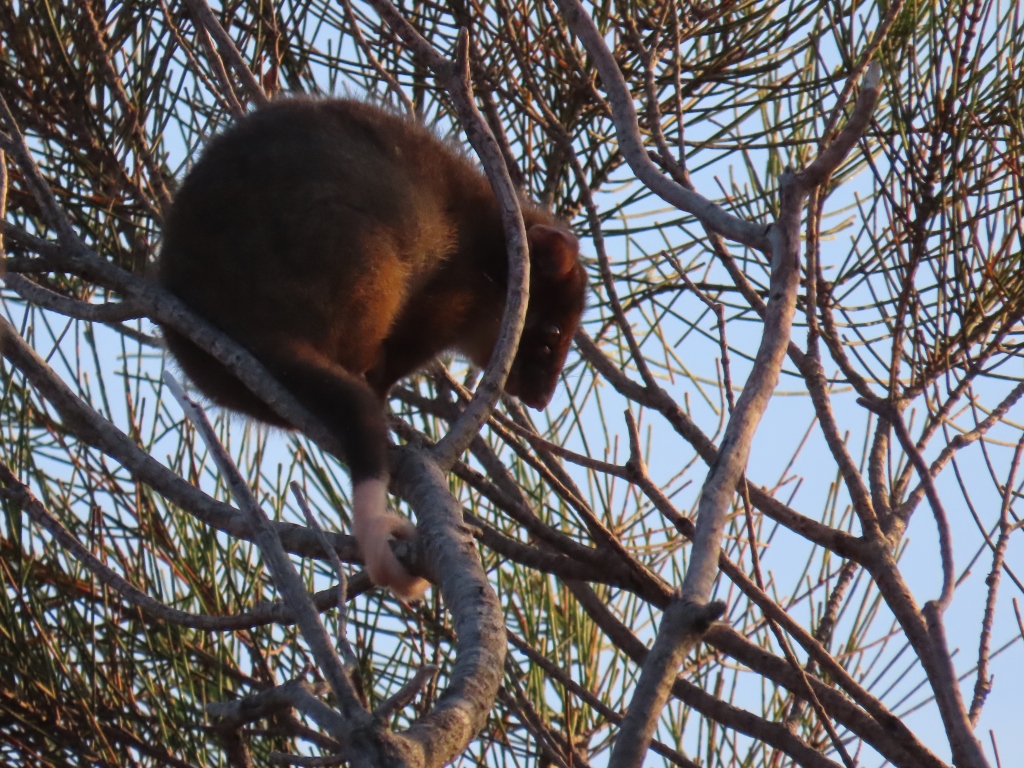
Common name: Eastern Ringtail Possum
Scientific name: Pseudocheirus peregrinus
Approximate length: 35 cm body plus another 30-35 cm tail
Date spotted: 24 December 2022 (summer)
Location: Dobroyd Head, Sydney Harbour, New South Wales, Australia: 33°48’36.6″S 151°16’21.2″E
Dolphins in Sydney Harbour on Christmas Day
As I was walking at Dobroyd Head on the shores of Sydney Harbour this morning, I spotted a pod of dolphins swimming below me. I think they’re Bottlenose Dolphins, as those are the most common around Sydney.
In the photo below, I’ve added a black rectangle to show the approximate area where the dolphins were swimming:

It was 6.45 am on December 25th. Christmas day! I was standing at a lookout on Dobroyd Head, overlooking Sydney Harbour. At the top of the picture is North Head on the left, and on the right is one of the rocky promontories that defines the southern side of the harbour entrance.
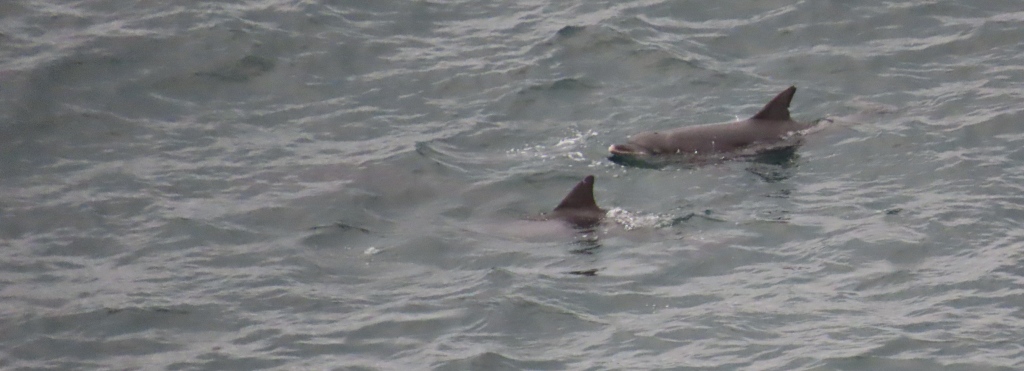

It was quite magical to see these creatures swimming below me. I’ve heard that there’s a study of the harbour’s dolphins happening at the moment, at Wild Sydney Harbour. The goal is to learn more about the behaviour of our dolphins and seals. I’ll let them know about this sighting.
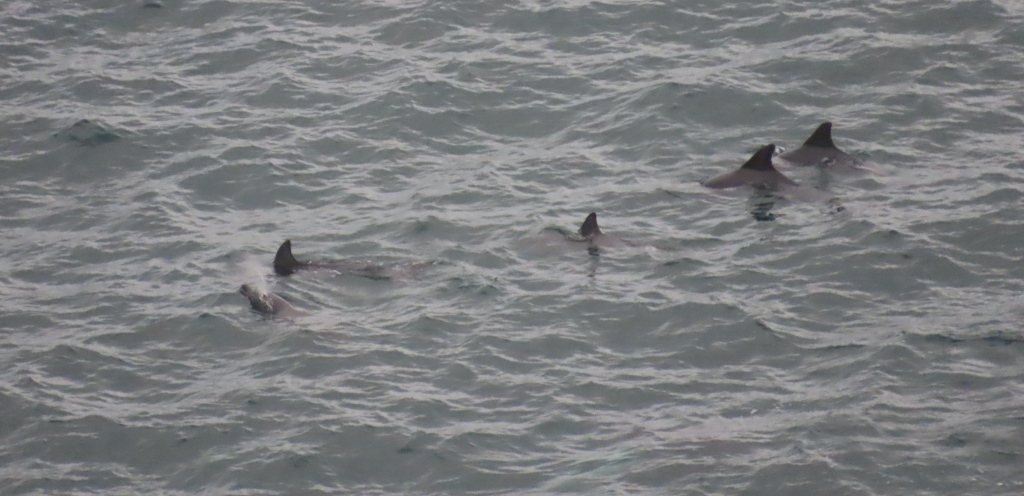
Black Jezebel butterfly
Out for a walk at Manly Dam Park north of Sydney this morning, I saw this pretty little butterfly. It’s a Black Jezebel (Delias nigrina). The undersides of its wings are quite colourful: black with yellow and red markings and some white snowy patches. The body is a fluffy yellow.

When the butterfly is flitting around, it looks entirely white, because you see only the top of its wings. In this video, you see glimpses of the white uppersides of the wings:
Moody pics of Huntsman spider on my bannister
Early one morning a few weeks ago, I encountered a huntsman spider on the bannister of a staircase inside my house. I was coming up the stairs from below, and was moving my hand along the top of the railing as I went. Then my head came level with the railing, and there was the spider at eye level.
First wildlife close encounter of the day, and I hadn’t even been outside yet! Life in Oz. 🙂
This is a big spider, about the size of the palm of my hand.
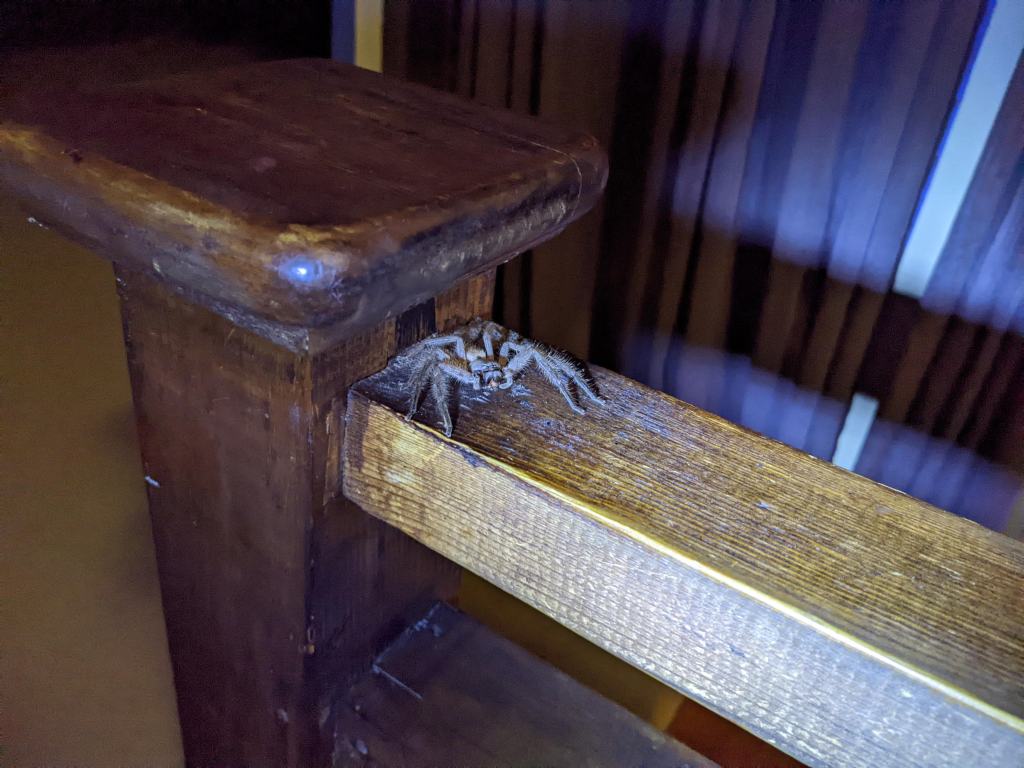
It looked as surprised as I was!
It was still dark and the lighting in this area of the house isn’t bright. I didn’t like using the flash on my phone too much, in case it damaged the spider’s eyes, so I found a torch. Hence the bluesy tone of this next photo:
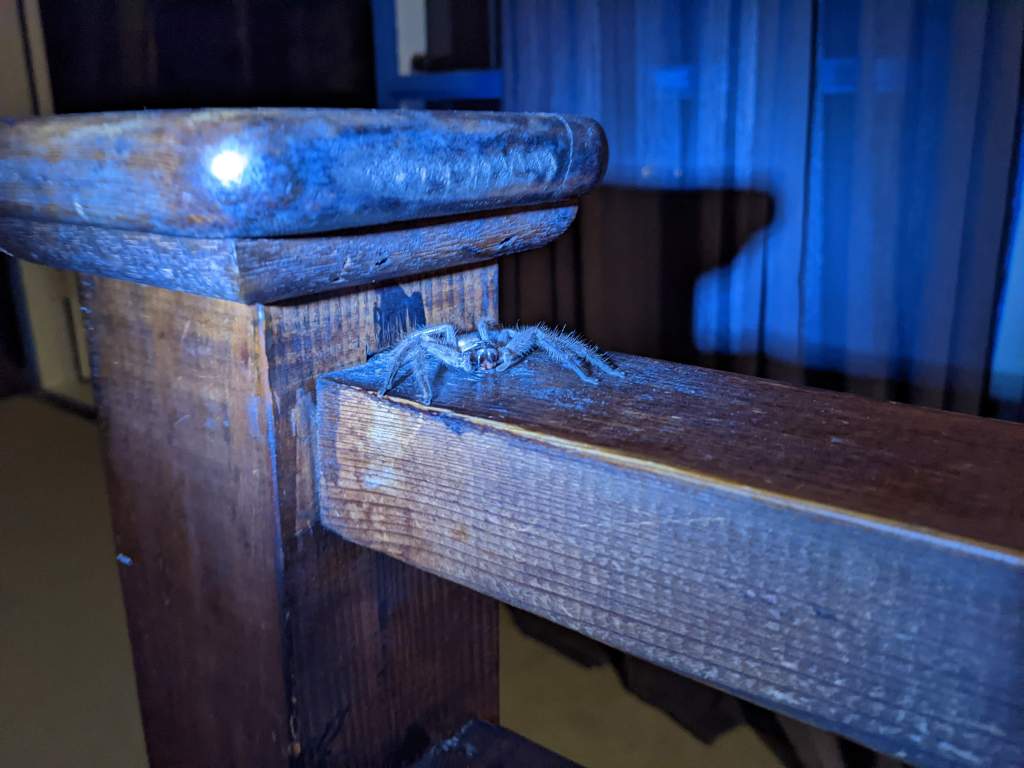
Huntsman spiders are big and scary, but they avoid contact with people if they can, and their venom isn’t too bad if they do bite. They won’t kill you, like some of the other Australian spiders.
Huntsmen generally run away from humans. They don’t go out of their way to bite unless actively threatened. This one might have had good reason to feel threatened by my hand coming towards it along the bannister, though!
And though we see them fairly often and I know they always run away, I do admit to uttering a restrained (not so much) gasp when I saw this one at eye level.
I was heading out for a walk, so I left the spider there, on the bannister, with a scribbled note next to it saying “spider” and an eloquent arrow, so that my husband wouldn’t have the same close encounter that I did.
When I came back, the spider had gone and my husband hadn’t seen it. Who knows where it is now? I’m sure I’ll see it again some early morning!
Large net-casting spider
While doing some gardening a couple of weeks ago, I came across this large, unique-looking spider. It was on my green bin, where I was about to deposit a load of garden trimmings. I didn’t want to hurt the spider, so I carefully moved it onto the nearby vegetation, after taking a couple of photos.
Here’s the spider, with my finger for scale:

It has its legs neatly clumped together in four groups of two. The body is long and thin, with two little humps on the sides about half way down the length. It’s head, seen from above, forms a neat triangle with two bulbs at the front.
Today I spent some time figuring out what type of spider it is. It turns out to be a net-casting spider. I wish I’d know that at the time! Evidently the spider has two huge eyes (under those bulbs seen here from above) and its face looks a little scary. As well as earning the name net-casting spiders, they’re also called ogre-faced spiders! I wish I’d got down onto the ground and looked at the spider from below, so that I could see its eyes and ogre face.
Here’s another picture, without the finger this time:

Why the name net-casting spider? These creatures spin a small square of web each night, which they hold in their front legs and cast over their prey. That’s why they have big eyes: to be able to see their prey in the dark.
Fascinating. It’s a jungle out there.









